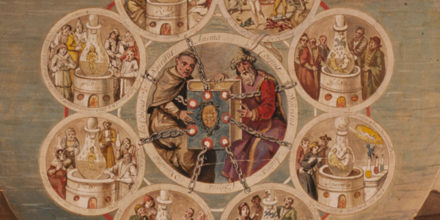
Morning from Times of Day, 1805, Philipp Otto Runge. Printmaker: J.G. Seyfert. Etching and Engraving. The Getty Research Institute, 2013.PR.35**
Philipp Otto Runge (1777–1810) is not a household name in the U.S., and his suite of four prints commonly known as the Times of Day are rarely seen here. We are fortunate to have recently acquired one of the extremely rare surviving sets of the first edition in a fantastic state of preservation. (Learn more about the acquisition and see all four prints here.)
Along with Caspar David Friedrich (1774–1840), Runge was a leading painter and theorist of the German Romantic movement. We now think of him as having rejected the tradition of academic painting in favor of highly personal art form that symbolizes the essential harmony of nature, humanity, and the divine. This in a way is true, but it’s equally valid to say that he relied, in part, on classical imagery to express the radical notions he absorbed from the likes of Baroque mystics who interpreted the world as metaphors and symbols. If this sounds complicated, it is. Runge’s creations, like other great masterpieces, are the subject of debate and open to interpretation. And while it’s hard work to interpret the exact meaning of the images, it’s easy to be seduced by their beauty and elegance. The Times of Day—Morning, Evening, Day, and Night—is a monument of German Romanticism and a milestone in the history of Western art.

Evening from Times of Day, 1805, Philipp Otto Runge. Printmaker: J.G. Seyfert. The Getty Research Institute, 2013.PR.35**
From 1802 until his untimely death at the age of 33 in 1810, Runge worked obsessively on these images, carefully articulating every aspect of their compositions. Early in the planning stages, he made four large outline drawings in preparation for the printed images. The first, small edition of the engravings was published in 1805 and captures the delicacy of Runge’s carefully constructed preparatory drawings. Runge’s original motivation to have his designs engraved was not commercial, as may have been the case when the second, altered edition was published in 1807. In fact, he shared the first edition with artists and writers in order to circulate his new ideas and to announce plans to create a large painting cycle based upon the designs. The painted cycle was never completed, which means that the prints provide a rare opportunity to glimpse Runge’s brilliance.
Admirers of these images are in good company, because their delicate purity was praised by none other than the towering figure of 18th-century German literature, culture, and science, Johann Wolfgang von Goethe. He displayed a set of the Times of Day in his music room, where he apparently exclaimed to a visitor, “it’s enough to drive you crazy, beautiful, and mad at the same time!”
The idea behind the “mad” iconography of Times of Day is the coming and departing of light, which points to the cycles of life from conception to death. Runge summarized his images with the following statements (in his original German, followed by English translation):
Der Morgen ist die grenzenlose Erleuchtung des Universums.
Der Tag ist die grenzenlose Gestaltung der Kreatur, die das Universum erfüllt.
Der Abend ist die grenzenlose Vernichtung der Existenz in den Ursprung des Universums.
Die Nacht ist die grenzenlose Tiefe der Erkenntniß von der unvertilgten Existenz in Gott
Morning is the boundless illumination of the universe.
Day is the boundless formation of the creature that fills the universe.
Evening is the boundless annihilation of existence into the origin of the universe.
Night is the boundless depth of the realization of the unobliterated existence in God.




Comments on this post are now closed.